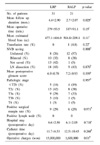Abstract
Purpose
Pure laparoscopic radical prostatectomy (LRP) and robot-assisted laparoscopic radical prostatectomy (RALP) are less invasive alternative techniques for localized prostate cancer. We report our initial surgical experience of LRP and RALP performed by a single surgeon.
Materials and Methods
Between October 2007 and August 2008, 31 and 21 patients were treated with LRP and RALP by the same surgeon, respectively, and both groups were similar in preoperative clinical parameters, including serum prostate-specific antigen (PSA) level, Gleason score (GS), and clinical stage. We analyzed the perioperative parameters and early short-term surgical outcome of LRP and RLRP by retrospective chart review.
Results
The mean surgical times for LRP and RALP were 279 and 337 min, respectively, and other perioperative data showed no significant differences between the 2 groups (all p>0.05) with the exception of the preservation rate of neurovascular bundles (58% LRP and 95% RALP, p=0.008). The pathologic parameters including the positive surgical margin rate of the 2 groups were comparable (29% LRP and 29% RALP, p>0.05). Immediately and at 1 month after catheter removal, the RALP group showed a better continence rate than did the LRP group (all p<0.05), but the overall continence rate was similar (80.6% LRP and 81% RALP, p=1.00). Operative charges for RALP were almost 9.4 times as high as those for LRP (p=0.03).
Figures and Tables
Fig. 1
Operation times (min) according to case group. LRP: laparoscopic radical prostatectomy, RALP: robotic-assisted laparoscopic radical prostatectomy.

Table 1
Preoperative characteristics of the patients who underwent laparoscopic or robot-assisted laparoscopic radical prostatectomy

References
1. Guillonneau B, Vallancien G. Laparoscopic radical prostatectomy: the Montsouris technique. J Urol. 2000. 163:1643–1649.
2. Schuessler WW, Schulam PG, Clayman RV, Kavoussi LR. Laparoscopic radical prostatectomy: initial short-term experience. Urology. 1997. 50:854–857.
3. Poulakis V, Dillenburg W, Moeckel M, de Vries R, Witzsch U, Zumbe J, et al. Laparoscopic radical prostatectomy: prospective evaluation of the learning curve. Eur Urol. 2005. 47:167–175.
4. Joseph JV, Vicente I, Madeb R, Erturk E, Patel HR. Robot-assisted vs pure laparoscopic radical prostatectomy: are there any differences? BJU Int. 2005. 96:39–42.
5. Park SY, Ham WS, Choi YD, Rha KH. Robot-assisted laparoscopic radical prostatectomy: clinical experience of 200 cases. Korean J Urol. 2008. 49:215–220.
6. Ahlering TE, Skarecky D, Lee D, Clayman RV. Successful transfer of open surgical skills to a laparoscopic environment using a robotic interface: initial experience with laparoscopic radical prostatectomy. J Urol. 2003. 170:1738–1741.
7. Menon M, Hemal AK, Tewari A, Shrivastava A, Bhandari A. The technique of apical dissection of the prostate and urethrovesical anastomosis in robotic radical prostatectomy. BJU Int. 2004. 93:715–719.
8. Hemal AK, Srinivas M, Charles AR. Ergonomic problems associated with laparoscopy. J Endourol. 2001. 15:499–503.
9. Kim SW, Hong SH, Hwang TK. Laparoscopic radical prostatectomy: the learning curve of the initial 150 cases. Korean J Urol. 2008. 49:879–885.
10. Frota R, Turna B, Barros R, Gill IS. Comparison of radical prostatectomy techniques: open, laparoscopic and robotic assisted. Int Braz J Urol. 2008. 34:259–268.
11. Menon M, Tewari A. Robotic radical prostatectomy and the Vattikuti Urology Institute technique: an interim analysis of results and technical points. Urology. 2003. 61(4):Suppl 1. 15–20.
12. Patel VR, Tully AS, Holmes R, Lindsay J. Robotic radical prostatectomy in the community setting--the learning curve and beyond: initial 200 cases. J Urol. 2005. 174:269–272.
13. Ban JH, Ko YH, Kang SH, Park HS, Cheon J. Learning curve with robotic-assisted laparoscopic radical prostatectomy: a prospective study. Korean J Urol. 2009. 50:140–147.
14. Rassweiler J, Seemann O, Schulze M, Teber D, Hatzinger M, Frede T. Laparoscopic versus open radical prostatectomy: a comparative study at a single institution. J Urol. 2003. 169:1689–1693.
15. Hsu EI, Hong EK, Lepor H. Influence of body weight and prostate volume on intraoperative, perioperative, and postoperative outcomes after radical retropubic prostatectomy. Urology. 2003. 61:601–606.
16. Kim YJ, Han BK, Byun SS, Lee SE. Comparison of perioperative outcomes of extraperitoneal laparoscopic radical prostatectomy (ELRP) versus open radical retropubic prostatectomy (RRP): single surgeon's initial experience. Korean J Urol. 2007. 48:131–137.
17. Cheng L, Darson MF, Bergstralh EJ, Slezak J, Myers RP, Bostwick DG. Correlation of margin status and extraprostatic extension with progression of prostate carcinoma. Cancer. 1999. 86:1775–1782.
18. Secin FP, Serio A, Bianco FJ Jr, Karanikolas NT, Kuroiwa K, Vickers A, et al. Preoperative and intraoperative risk factors for side-specific positive surgical margins in laparoscopic radical prostatectomy for prostate cancer. Eur Urol. 2007. 51:764–771.
19. El-Hakim A, Leung RA, Tewari A. Robotic prostatectomy: a pooled analysis of published literature. Expert Rev Anticancer Ther. 2006. 6:11–20.
20. Ficarra V, Cavalleri S, Novara G, Aragona M, Artibani W. Evidence from robot-assisted laparoscopic radical prostatectomy: a systematic review. Eur Urol. 2007. 51:45–55.
21. Lepor H, Kaci L. Contemporary evaluation of operative parameters and complications related to open radical retropubic prostatectomy. Urology. 2003. 62:702–706.
22. Trabulsi EJ, Guillonneau B. Laparoscopic radical prostatectomy. J Urol. 2005. 173:1072–1079.
23. Rassweiler J, Binder J, Frede T. Robotic and telesurgery: will they change our future? Curr Opin Urol. 2001. 11:309–320.
24. Kang MY, Ku JH, Kwak C, Kim HH. The learning curve analysis of laparoscopic radical prostatectomy: comparison with retropubic radical prostatectomy. Korean J Urol. 2008. 49:18–23.
25. Artibani W, Grosso G, Novara G, Pecoraro G, Sidoti O, Sarti A, et al. Is laparoscopic radical prostatectomy better than traditional retropubic radical prostatectomy? An analysis of peri-operative morbidity in two contemporary series in Italy. Eur Urol. 2003. 44:401–406.
26. Eden CG, King D, Kooiman GG, Adams TH, Sullivan ME, Vass JA. Transperitoneal or extraperitoneal laparoscopic radical prostatectomy: does the approach matter? J Urol. 2004. 172:2218–2223.
27. Burgess SV, Atug F, Castle EP, Davis R, Thomas R. Cost analysis of radical retropubic, perineal, and robotic prostatectomy. J Endourol. 2006. 20:827–830.




 PDF
PDF ePub
ePub Citation
Citation Print
Print






 XML Download
XML Download